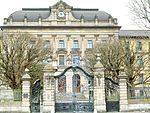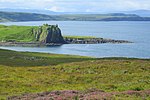Emerald green (film)
| Movie | |
|---|---|
| Original title | Emerald green |
| Country of production | Germany |
| original language | German |
| Publishing year | 2016 |
| length | 112 minutes |
| Age rating | FSK 12 |
| Rod | |
| Director |
Felix Fuchssteiner , Katharina Schöde |
| script | Katharina Schöde, Felix Fuchssteiner, Barry Thomson |
| music | Philipp F. Koelmel |
| camera | Ralf Schlotter , Florian Emmerich |
| cut | Nicole Kortlüke |
| occupation | |
| |
| chronology | |
|
← Predecessor |
|
After ruby red and sapphire blue, emerald green is the third and final part of the “ gemstone trilogy ”. The film premiered in German cinemas on July 7, 2016. As in the previous parts, Maria Ehrich and Jannis Niewöhner play the leading roles . Other roles will include a. played by Josefine Preuß , Florian Bartholomäi , Laura Berlin and Katharina Thalbach .
action
The 16th birthday of Gwendolyn Shepherd ("Gwen") revealed more secrets and surprises to her than she would have liked. On this day, her time travel gene was activated for the first time, making her jump into the past a few hours a day. Since then, she has had to work with the Count of St. Germain's mysterious secret box, which she is the twelfth and last of the time travelers to call “ Rubin ” or “Rabe”, in order to make controlled leaps in time with the aid of a device known as the “chronograph”. There she was only met with suspicion, especially when it turned out that her birth parents were the renegade time travelers Lucy and Paul, known as "Saphir" and "Tourmaline", who stole the 2nd Chronograph and hid in the past.
On the missions to the former Genträgers, she is constantly accompanied by Gideon de Villiers, the male time traveler of her generation. In order to cope with the many life-threatening situations, they learned to trust each other and ultimately fell in love. But when Gwendolyn learns from Count St. Germain that Gideon's feelings for her were only played out at his behest, she is deeply hurt.
Gwendolyn has meanwhile broken off contact with the lodge, only her best friend Leslie, her great-aunt Maddy and the butler Mr. Bernhard know that, with the help of the second chronograph that she and Leslie found between the walls of their house, they daily their parents in the previous one Century. Lucy and Paul have gathered a lot of evidence suggesting that the Lodge, especially the Count, has less charitable aims.
Gideon, on the other hand, studies the memoirs of Count St. Germain, which Paul entrusted to him on condition that he should protect Gwen. The difficult-to-interpret prophecies indicate that Gwen's love for him will lead to her death.
The imminent event, the extraction of the long-awaited cure through the union of the blood of all gene carriers that are read into the chronograph, causes Mr. Whitman to set himself up as lodge master and get rid of uncomfortable personnel like Mr. George and Mrs. Smith. The contact persons in all national and international institutions, companies and secret services are activated in order to be able to implement the grand plan.
Despite the great disappointment of not being the chosen time traveler, Gwen's cousin Charlotte still feels obliged to the lodge and reports her suspicion that Gwendolyn is secretly using the second chronograph. But after the guards of the lodge not only ransacked Gwen's room, but also broke into Gideon's apartment and knocked down his younger brother Raphael, they question themselves and the higher goals of the lodge. Mr Bernhard, who turns out to be her and Gwen's nephew, hid the chronograph in time, but since Gwen is now in imminent danger, he brings her with the device to a safe hiding place, in Lucy and Paul's cottage.
Gideon is instructed by the lodge to deliver a message to Count St. Germain in the past, so the Count learns of the new developments and has Gideon imprisoned immediately. When Gideon jumps back tied up into the present, Mr. Whitman awaits him and records a video for Gwen to exchange his life for the second chronograph, because this device only lacks Gideon's blood to extract the mystical cure. Gwen, who continues to visit her parents every day in the past, hatches a plan with them to save Gideon's life and at the same time prevent the lodge from threatening world domination.
She goes into the conditions of the handover, which is to take place in 1786 during the " Bonfire Night " in the Count's house. Since she can now trust Charlotte, Gwen instructs her cousin to visit Gideon in his prison and secretly slip him the key so that he can flee that night and rush to her aid. The plan only works to a limited extent, because Gideon cannot prevent the count from drawing blood before he escapes. Even his timely appearance at the delivery point cannot prevent the creation of the panacea, which in truth confers immortality. Gwen and Gideon are killed, the count takes the serum, transforms into his younger self and gives up his disguise as Mr. Whitman in the present. In his certainty of victory, he does not have the dead bodies of the lovers disposed of; they are taken away by Mr. Bernhard, Charlotte and Raphael.
But Gwen comes back to life, she seems to be immortal as the child of two gene carriers. She cannot and does not want to accept Gideon's death. In her great grief, she longs to return to her parents and discovers that she can make targeted jumps in time even without a chronograph. A new courage to live arises in her and she is determined to fight for Gideon. Much better prepared and trained in Krav Maga , she travels again to Bonfire Night and can finally overpower the Count and heal Gideon's injuries with the resulting elixir, the immortalizing philosopher's stone .
In a café in the 1920s, she drinks this tincture that she has saved and thus becomes mortal again.
Filming
The shooting of the film Smaragdgrün took place from April 14 to June 11, 2015 in Aachen , Jülich , Nordkirchen , Mühlhausen / Thuringia , Eisenach , Coburg , Bayreuth and Scotland .
In the city region of Aachen in particular , people were looking for suitable motifs that matched Anglo-Saxon architecture from different eras, as the grant money from the Film- und Medienstiftung NRW was also intended as an economic promotion for North Rhine-Westphalia . In Stolberg - Breinig , a stone house on Stockemer Straße was converted into a Scottish cottage for Lucy and Paul , the Kupferhof Rosenthal was again the location, this time the Charleston scene from 1925 was shot in the ballroom , and some street scenes were created in Luciaweg at Stolberger Burg in Bonfire Night and the encounter with Shakespeare . In Aachen itself, the interior shots of the high school scenes were filmed in the Kaiser-Karls-Gymnasium and the stairs of the AachenMünchener headquarters represented the modern City of London . Because of the great logistical effort, this time shooting in the Aachen cathedral courtyard was not done. However, the scenes in the secret passages and in the dungeon of the lodge were recorded in the casemates of the Jülich Citadel, as in the two previous parts . The Nordkirchen in Münsterland had to for this part of the trilogy as St. Lennox High School or as an estate of Lord Pimplebottom selected because on the one hand, the castle was not Ehrenburg for renovations available and secondly the baroque park offered suitable motifs for the day and night shots in the palace garden.
In Thuringia , people returned to tried and tested locations to film scenes inside the guard's lodge. The old chancellery of the Mühlhausen town hall was redesigned this time into Mr. Whitman's office or Gwendolin's cloakroom and the ballroom of the Wartburg was once again the ceremonial hall of the lodge .
In Bavaria , too , they were filming again in locations that were already known from previous films. The premises of the former Ketschendorf Castle Youth Hostel were again furnished as the residence of the Montrose family and Gwen's room , and this time the scenes of the Bonfire Night in 1786 were recorded in the baroque rooms of the Margravine Wilhelmine High School in Bayreuth . For the associated outdoor shots, they also shot in the labyrinth of Fantaisie Castle in Donndorf .
Glenelg Ferry Terminal , Scotland
The final filming took place in Scotland , as the coastal landscapes of the Isle of Skye served as the setting for Lucy and Paul's Cottage . On the Glenelg Ferry , the crossing to Gwen's hiding place was shot , the funeral ceremony took place on the beach below Duntulm Castle and Gwen's combat training with Paul was even filmed on the cliffs of the Quiraing with the help of a 360-degree drone flight.
criticism
In contrast to the previous film, the epd Film's criticism is milder: Frank Arnold compares emerald green with its predecessor, sapphire blue , with which the film shares its main topic, the question of trust. Emerald green manages to strike a balance between romance and action, while the comic parts are limited in this part of the series. As before, the qualities of American genre role models like Panem are not quite matched.
“The filmmakers have also provided the finale of their trilogy with some current allusions that are not found in the novel, so if the Lodge is also active on Wall Street, the final confrontation takes place during Guy Fawkes Night or when once the "complete surveillance of privacy" is denounced. That doesn't go as far as in the Hunger Games film series, but it shows the possibilities that the genre offers. "
particularities
- The ruby red scene of the “double me” during a ball at Lord Pimplebottom's is not taken up again in either sapphire blue or emerald green .
- The final scene from the 1920s of the film Saphirblau only appears as the final scene of emerald green and is not related to the actual plot.
- After the credits there is an alternative ending, which consists of Gideon drinking the elixir and thereby also becoming immortal.
Web links
- Emerald green in the Internet Movie Database (English)
- Emerald green at filmportal.de
Individual evidence
- ↑ Release certificate for emerald green . Voluntary self-regulation of the film industry (PDF; test number: 157533 / K).
- ^ "Smaragdgrün": extras wanted for filming. Aachener Nachrichten , March 11, 2015, accessed on July 11, 2016 .
- ↑ Günter H. Jekubzik: Movie "Smaragdgrün": Shot in Aachen, Stolberg and Jülich. Aachener Nachrichten , July 2, 2016, accessed on July 11, 2016 .
- ↑ Heike Eisenmenger: "Smaragdgrün": Because Scotland is actually in Breinig ... Aachener Nachrichten , April 16, 2015, accessed on July 11, 2016 .
- ↑ Sebastian Reith: Nordkirchen Castle as a backdrop with a photo series. Dorstener Zeitung, May 6, 2015, accessed on July 12, 2016 .
- ↑ Claudia Bachmann: City Hall was the third location for a children's film trilogy. Thüringer Allgemeine , May 17, 2015, accessed on July 13, 2016 .
- ↑ Helke Renner: Shooting for Smaragdgrün: The last flap for Coburg. inFranken.de, May 27, 2015, accessed on July 11, 2016 .
- ↑ Ute Eschenbacher: "Smaragdgrün": Bayreuth high school as a film set. Nordbayerischer Kurier , May 29, 2015, accessed on July 11, 2016 .
- ^ Frank Arnold: Critique of emerald green . In: epd-film.de. epd Film , June 24, 2016, accessed May 26, 2018 .








